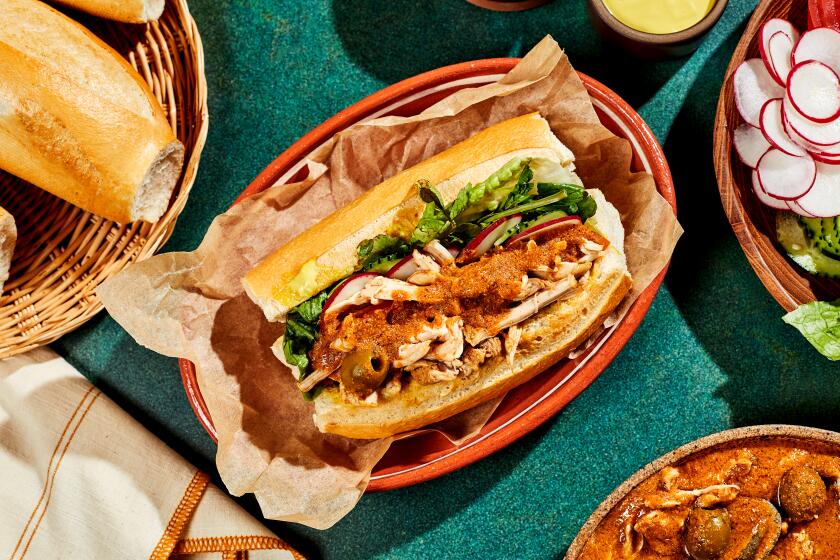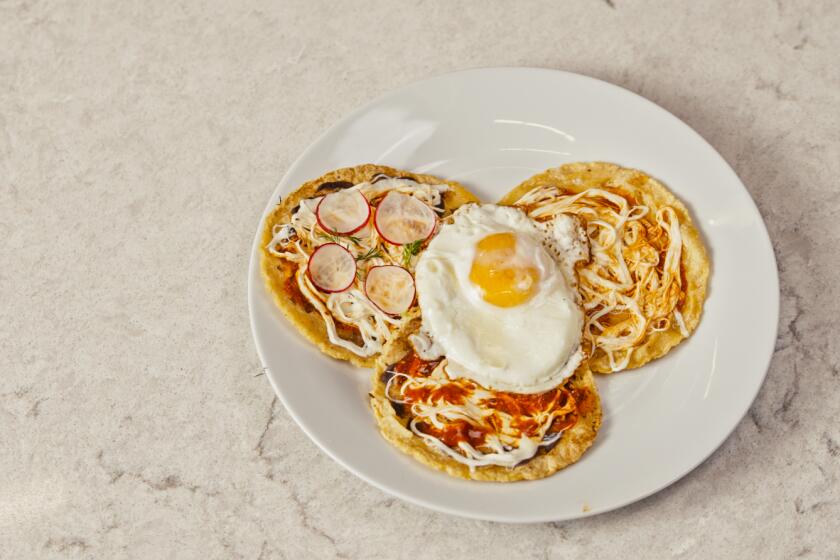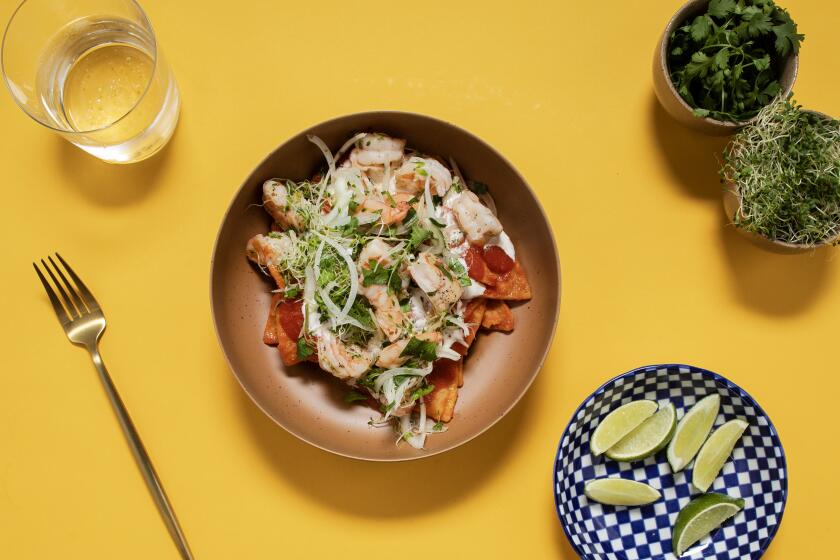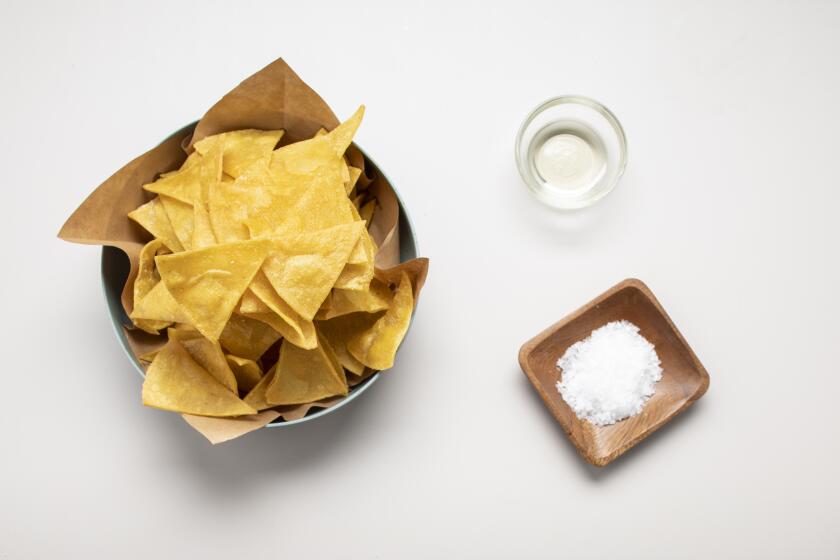Baptist cakes
- Share via
John T. Edge is kind of infuriating.
On one hand, the food writer and director of the Southern Food Alliance has a noble curiosity about quirky small-town ways. It’s spurred him to collect lots of regional recipes, resulting in a series of four books: “Fried Chicken,” “Apple Pie,” “Hamburgers & Fries” and the latest, “Donuts.” Each consists of leisurely accounts of his quests for one specialty or another, with a recipe from his travels at the end of most chapters.
He’s spent a load of time visiting off-the-beaten-track restaurants all around the country, and he records their food ways with zest: chile-spiked apple pie, doughnuts caked with crushed Oreo cookies, the San Antonio hamburger that’s topped with refried beans, corn chips and spray-can cheese spread.
This is fascinating stuff. If he’d stick to a chronicler’s role, Edge could be our Charles Kuralt of road food, wandering down the nation’s byways and gabbing with small-town eccentrics. (He has a taste for eccentricity, and sometimes you may get the feeling he’s laying it on a little thicker than life.)
On the other hand, he dabbles in food history from time to time, and he’s not that well-informed or discerning about his sources. (Mind you, I feel odd saying so, because he quotes me in the burger book.)
For instance, he has a bee in his bonnet that fried chicken is African and confidently writes, “We do know this: the tradition of cooking in deep oil has probably West African antecedents.” West Africans do fry things, mostly little cakes -- the hush puppy is certainly African -- but batter-frying is Spanish. We have medieval recipes to prove it.
Well, there’s a lot of half-accurate food history out there. What makes Edge uniquely infuriating is the way he writes this mixture of genuine food lore and guesswork history.
Purple prose
He’s won awards for his writing, but it’s the kind of prose a newspaper copy editor could wear out a red pencil on. Edge never uses one word when he can get away with three or four -- which is hard to take in books as small as these (about 5 by 7 inches, averaging 175 pages). And he’s addicted to the overblown language restaurant reviewers used to throw around 30 years ago: “iconic,” “transcendent,” “pantheon,” “acolyte” and all that.
Put it all together and you get sentences such as this: “But even the luxurious drape of two emerald-colored lobes on a burger capped with cheddar can seem a kind of self-conscious attempt to claim terroir for a dish that was not born here amidst the pinon and juniper.”
Apparently this means something like it’s bogus for people in New Mexico to put green chiles on cheeseburgers because they didn’t invent the cheeseburger. Altogether, Edge often seems to be all glaze and no doughnut.
But give him his due, he has visited all those out-of-the-way restaurants. And he has clearly put a good deal of thought into the recipes he includes in this book.
There aren’t many of them, only about 15 per book, but on the whole (for some reason, the doughnut range doesn’t have many surprises) they’re both unusual and worth trying. He has not hesitated to tinker with some of them to make them better; for instance, changing a traditional milk custard to a buttermilk custard for richness.
Some of them do need a bit of tweaking. The hypocrite pie recipe calls for one cup of sugar but only uses three-fourth cup; we decided three-fourths cup was right. The strawberry doughnut recipe from Glendora’s famed Donut Man shop doesn’t mention mixing the strawberries with syrup for the filling, and we found its dough needed more water than specified.
Edge encounters some dishes for which he doesn’t give recipes -- understandable in the case of the soy-extended “slug burger” or flour-extended “dough burger” of northeastern Mississippi. Apple pie milk shake, yes; even doughnut soup, yes; but no slug burger.
I’m glad he’s left in the PC burger (“PC” standing for pimento cheese), which is topped with a mixture of pimentos, green onions, mayonnaise and six (6!) ounces of extra-sharp cheddar. It makes you proud, somehow, to know you have fellow citizens who can put away PC burgers and live. You might even think it’s worth wading through Edge’s pirouetting prose to discover such down-home marvels.
Dissolve the yeast in one-half cup warm water, stirring.
Meanwhile, in a large bowl, combine 1 cup cool water, the milk, salt and sugar.
Add the yeast mixture and the shortening. Add the flour, stirring until the mixture is stiff.
Remove the dough to a floured work surface and knead as you would bread, until a rough ball can be formed.
Grease a heat-proof bowl or kettle with the softened butter. Place the dough in the bowl and cover with plastic. Store in a warm place until the dough doubles in size, about 1 hour.
Roll the dough out with a rolling pin to a thickness of one-half inch, then cut into 2-inch squares. Place on a cookie sheet and cover with plastic. Set aside for 15 minutes.
Pour the oil into a cast-iron Dutch oven or other deep, heavy-bottomed pot until it reaches a depth of 3 to 4 inches. Heat the oil to 360 degrees. Fry each square for 1 to 2 minutes per side or until golden on both sides. Remove with a slotted spoon to dry on wire racks.
Serve with a dunking bowl of warm milk topped with a pat of butter, or maybe a bowl of maple syrup heated until warm.
Get our Cooking newsletter
Get a taste of Los Angeles — and the world — with recipes and kitchen tricks from the L.A. Times’ Cooking newsletter.
You may occasionally receive promotional content from the Los Angeles Times.















